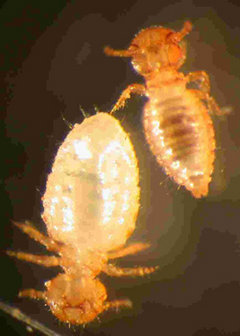Lice
Lice (singular: louse) (order Phthiraptera) are an order of over 3000 species of wingless parasitic insects. more...
They are all obligate ectoparasites of mammals and birds, excluding the Monotremes (the duck-billed platypus, the Echidna and spiny ant-eater) and bats.
A louse egg is commonly called a nit. Lice stick their eggs to their host's hair. A nit comb is a comb with very fine close teeth to scrape nits off the hair.
The order has traditionally been divided into two suborders; the sucking lice (Anoplura) and chewing lice (Mallophaga), however, recent classifications suggest that the Mallophaga are paraphyletic and four suborders are now recognised:
- Anoplura: sucking lice, including head and pubic lice (see also Pediculosis or Head lice)
- Rhyncophthirina: parasites of elephants and warthogs
- Ischnocera: avian lice
- Amblycera: chewing lice, a primitive order of lice
Lice are highly host specific and many species even prefer specific sites on their host's body. As lice spend their whole life on the host they have developed adaptations which enable them to maintain a close contact with him or her. These adaptations are reflected in their size (0.5 mm to 8 mm), stout legs and claws in order to cling tightly to hair, fur and feathers, wingless and dorsoventrally flattened. They feed on skin (epidermal) debris, feather parts, sebaceous secretions and blood. A louse's colour varies from pale beige to dark grey; however, if feeding on blood, it may become considerably darker.
The picture depicts the chewing louse Damalinia limbata found on Angora goats. The male louse (right) is typically smaller than the female (left), whose posterior margin of the abdomen is more rounded than those of male lice.
External Links
- How to Get Rid of Lice informational article at wikiHow
Read more at Wikipedia.org



